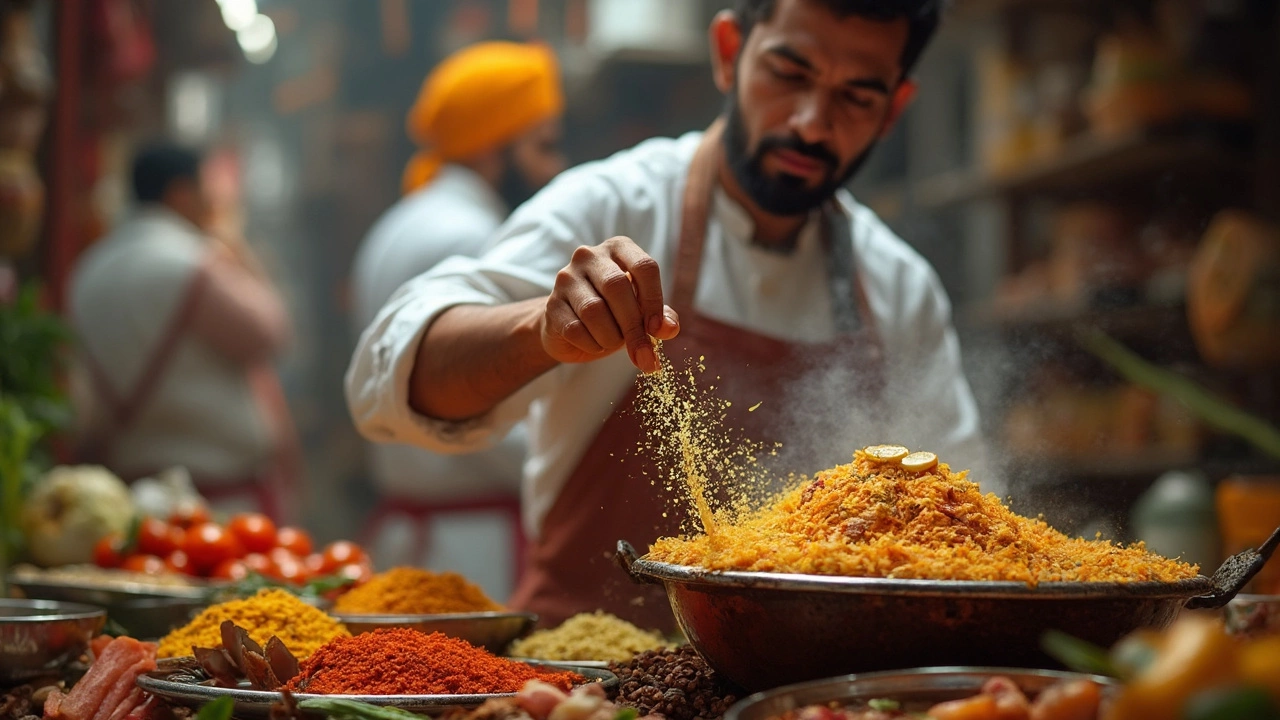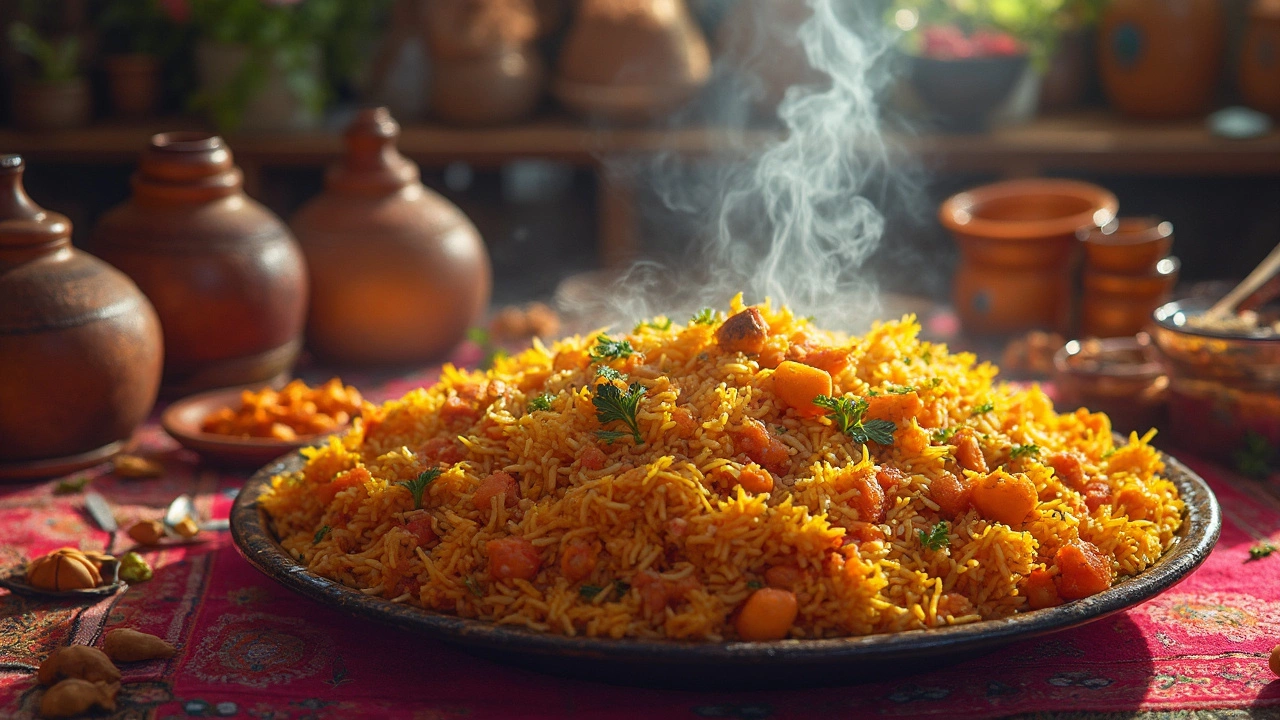6 Apr 2025
- 0 Comments
Biryani isn't just a dish; it's an experience of flavors dancing together with grace and precision. Ever wondered how it gets that unforgettable aroma? The secret lies in the essences, specifically rose water and kewra water. These two play a crucial role in transforming good biryani into an unforgettable one.
So what's the deal with these essences? They're basically distillations that capture the fragrance of flowers. Used sparingly, they add an elegant, floral note that complements the spices without overwhelming them. But beware—overdoing it can completely hijack your dish's flavor profile. It's all about balance.
For beginners: getting started with rose and kewra water might seem a bit daunting, but it's simpler than you think. A few drops are usually all you need to start. Don’t worry; we'll get into more detailed, practical advice later on. But for now, know that a little goes a long way in making your biryani aromatic and delicious.
- The Essential Role of Essences in Biryani
- Common Types: Rose Water and Kewra
- How to Use Essences in Your Recipe
- Enhancing Flavor Without Overpowering
The Essential Role of Essences in Biryani
Imagine biting into a plate of biryani and being instantly hit with an aroma that makes your taste buds do a happy dance. That's the magic of essences at work. In biryani, the strategic use of essences, particularly kewra water and rose water, is key to the dish's signature appeal. They're not about stealing the spotlight but enhancing it, adding layers of interest to every mouthful.
Kewra water comes from the pandanus flower, providing a sweet, floral yet slightly fruity scent. It's especially common in Hyderabadi and Lucknowi biryanis. What's interesting is how it interacts with the spices, pumping up the aroma without overpowering the underlying savory notes.
Then we've got rose water, a staple that brings a delicate floral touch, known for its use in Mughlai cooking. It sets the mood by adding freshness and a hint of sweetness, effortlessly elevating the overall flavor profile.
Want to know how they work in harmony? Consider them like the essential characters in a movie. Each essence plays a significant yet supporting role, making sure that the spices like cumin and cardamom shine brighter, while the saffron gets to sparkle with its bold color and subtle flavor contributions.
Here's a fun fact: in some biryanis, these essences are used at the very end of the cooking process. This is because high temperatures can dull their fragrance. A few drops added when the heat is turned off will diffuse a wonderful aroma, ensuring you get the most out of every bite.
Understanding this not only helps in elevating your dish but also brings you closer to mastering what many might consider an art form. The world of biryani is expansive, but knowing the role of these essences can certainly give your culinary skills a flavorful boost.
Common Types: Rose Water and Kewra
When it comes to crafting a truly divine biryani, the choice and use of essences like rose water and kewra water can make all the difference. These two fragrant essences are often used to enhance the aroma and flavor of this beloved dish, but what's the scoop on how they work their magic?
Rose Water is made from distilling rose petals with steam. It’s got a light, floral scent and is used not just in Indian cooking but also in skincare. In biryani, rose water adds a subtle sweetness and a rich aroma without tasting like perfume. A little tip: because it’s quite potent, less is more—just a few drops should do the trick.
On the other hand, Kewra Water is derived from the pandanus flower, giving it a distinct but delightful aroma. It’s often compared to the scent of freshly cut grass mixed with a hint of rose. When using kewra in your biryani recipe, you want to mimic the breeze of a garden, not a jungle. So, measure carefully—usually around a teaspoon for a large pot of biryani does wonders.
Rose water and kewra serve as the secret ingredients for elevating the biryani experience. They might not be the stars of the show, but without them, your biryani could miss out on that traditional touch that makes it so irresistible. Remember, a little experimentation is okay, but start light and adjust as your tastebuds guide you.

How to Use Essences in Your Recipe
Using essences like kewra water and rose water in your biryani can take your dish to a whole new level. But before you douse your rice with floral infusions, let’s talk about the right way to incorporate these aromatic wonders.
First, timing is everything. The best moment to add essences is during the final stage of cooking. Just before you start the final dum (or steaming) process, sprinkle a few drops over the rice. This allows the essence to infuse as the biryani finishes cooking, giving you that heady aroma when you lift the lid.
Here’s a simple guide to help you use essences properly:
- Measure Carefully: Use a dropper or spoon to avoid overdoing it. Typically, you need just 2-3 teaspoons for a large pot serving about 4-5 people.
- Mix Smart: You can mix a bit of rose water with milk or cream before adding to the biryani. This helps in spreading the essence evenly across the dish.
- Layer Wisely: When you're layering rice and meat, sprinkle the essence on the topmost layer. This ensures the top layer is fragrant, which will permeate through the entire dish as it steams.
If you're skeptical about using both rose water and kewra water together, start with one and see how you like it. Each brings its own charm to the table. Some biryani lovers prefer one over the other, while some go for a mix for a unique aroma.
Remember, it's about striking the right balance. Too much of these essences, and you'll risk overpowering the rich flavors of your masalas and meat. As with any cooking adventure, it’s all about finding that sweet spot where everything works in harmony.
Enhancing Flavor Without Overpowering
We all know biryani is like a festival in a pot. But ever added too much seasoning and felt like you crashed the party? While biryani essences like rose water and kewra water are magic touches, using them without caution can turn that magic into a mishap.
First things first, less is more. These essences are powerful, so minimal use is crucial. Think of it as adding perfume; a couple of spritzes are enough to leave an impression. In terms of measures, start with just a teaspoon for a standard pot serving about four. If you’re not sure, it's better to add gradually. Always taste before deciding to add more.
Another trick to avoid overpowering is to dilute these essences with a bit of water before mixing them into the biryani. This helps to distribute the flavor more evenly. Mixing the essence with the rice just before the final steam also allows the aromatic profiles to blend rather than clump together.
- Tip 1: Only add essences in the last 5 minutes of cooking to maintain freshness.
- Tip 2: Combine rose water and kewra water with saffron for a richer palette of flavors.
- Tip 3: Always use high-quality, authentic essences; there's a big difference in potency and purity.
It might surprise you, but a study found that over 80% of people enjoy dishes with a mild scent rather than overpowering ones. No one wants to feel like they're eating perfume, right?
If you're used to measuring with your heart, remember that with biryani, especially with essences, precision is your friend. Treat them as a friendly whisper of flavor rather than a booming voice. Done right, these tiny drops can elevate your biryani recipe and turn your meal into an aromatic delight.
